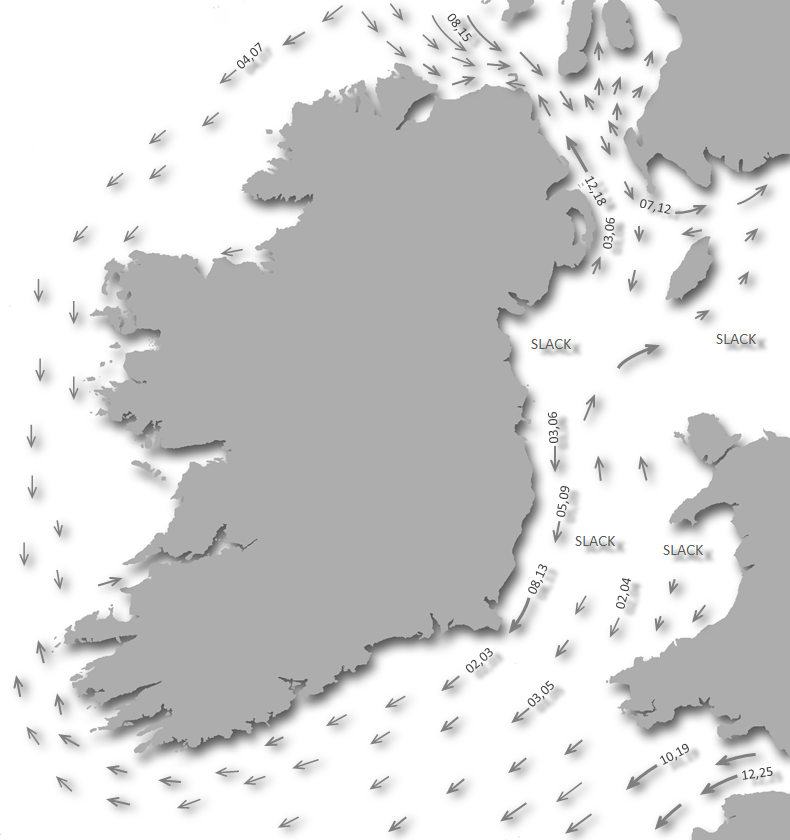

The anchorage and pier are on the south-east side of the head. The latter almost dries at low water and with westerly gales the sea breaks all over the shallow anchorage. It is nevertheless the only anchorage between Sligo and Donegal harbours, and during the summer months may be considered generally safe.
Keyfacts for Mullaghmore







Nature







Considerations


Protected sectors


Summary* Restrictions apply
A good location with straightforward access.






Nature







Considerations


Position and approaches
Haven position
 54° 27.947' N, 008° 26.828' W
54° 27.947' N, 008° 26.828' Wthis position is at the pierhead at Mullaghmore
What is the initial fix?
 54° 31.206' N, 008° 27.571' W
54° 31.206' N, 008° 27.571' W Not what you need?
- Inishmurray - 7.8 nautical miles WSW
- Killybegs - 10.2 nautical miles N
- Rosses Point - 10.6 nautical miles SSW
- Brown Bay - 11.1 nautical miles SW
- Sligo - 11.5 nautical miles S
- Teelin - 11.5 nautical miles NW
- Donegal Town Harbour - 13 nautical miles NE
- Ballysadare Bay - 13.8 nautical miles SSW
- Aughris Hole - 15.8 nautical miles SW
- White Strand Bay - 16.4 nautical miles NW
- Inishmurray - 7.8 miles WSW
- Killybegs - 10.2 miles N
- Rosses Point - 10.6 miles SSW
- Brown Bay - 11.1 miles SW
- Sligo - 11.5 miles S
- Teelin - 11.5 miles NW
- Donegal Town Harbour - 13 miles NE
- Ballysadare Bay - 13.8 miles SSW
- Aughris Hole - 15.8 miles SW
- White Strand Bay - 16.4 miles NW
Chart
How to get in?
 The 'Erris Head to Malin Head' coastal description provides approach information to the suggested initial fix. Vessels approaching from the south should select the northeast bound
The 'Erris Head to Malin Head' coastal description provides approach information to the suggested initial fix. Vessels approaching from the south should select the northeast bound  sequenced description; vessels approaching from the north should select the southwest bound
sequenced description; vessels approaching from the north should select the southwest bound  sequence; western approaches may use either description.
sequence; western approaches may use either description.Mullaghmore is situated on the northwest coast of Ireland in County Sligo sixteen miles north of Sligo town. It lies on the southern shore of Donegal Bay, Ireland's largest bay which is open to the west to the Atlantic Ocean. A small seaside fishing village, Mullaghmore is located on a peninsula to the east of the rocky cliffs of Mullaghmore Head and features a beach and a picturesque stone built harbour.
Mullaghmore is a good anchorage for yachts up to 10 metres long and when moored within the harbour offers good shelter protection and is generally safe in any weather. Berthing alongside either the north or south piers is convenient, the south usually being the more sheltered. The harbour nearly dries so although the access is straightforward it is best at HW when the depth is 2 metres, and care should be taken when entering or leaving to keep near to the north pier as there are drying rocks adjacent to the south pier at the entrance to the harbour. It is also worth noting that it was reported in June 2012 at a Sligo County Council meeting that a sandbank has built up over the years at the entrance to the harbour and is now causing problems for some boat owners.
Why visit here?
Mullaghmore, Irish : An Mullach Mor meaning “the great summint” is one of County Sligo's noted holiday destinations, on its western side lie the rocky cliffs of Mullaghmore Head that defy the Atlantic gales, whilst to the east lies a golden sandy beach and the scenic harbour which is well sheltered from the Atlantic Ocean.A popular holiday centre characterised by ocean views and a skyline dominated by the monolithic shape of Ben Bulben mountain, Mullaghmore's facilities include a superb blue flag beach that stretches for about 2 miles that is safe for swimming and other watersports particularly surfing and windsurfing. Mullaghmore is one of the best big wave surfing locations in the world caused by a combination of a direct west facing location and the funnel shape of Donegal Bay. The westerlies of the Atlantic Ocean get funnelled into a relatively small area which increases the size of the swell. In March 2012 surfers and windsurfers from all over the world travelled to Mullaghmore to ride waves of up to 50 feet high off Mullaghmore head. The harbour also has a renowned reputation for being a base for licensed sea fishing and angling with local boats being hired by tourists during the summer season.
A favourite destination for the charter boats leaving Mullaghmore harbour is Inishmurray Island situated in the Atlantic Ocean to the southwest of Mullaghmore Head. The island which is 1 mile long and 0.5 mile wide ceased to be inhabited in 1950 but is interesting for its antiquities enclosed by a great wall. There was originally a pagan stone fort here converted into a monastery by St. Molaise in the early 6C and the island is well worth a visit weather permitting to see the remarkably well preserved 6C monastic buildings. There are natural quays and mooring rings where the local charter boats go alongside, and these also provide for good dinghy landings.
The first owner to set foot on the conquered lands of north Sligo was Henry John Temple the 3rd Viscount Palmerston who arrived in 1808. He is best known as Lord Palmerston who served two terms as Prime Minister of England. It was he who commissioned the building of Classiebawn Castle on a hill overlooking Mullaghmore, a fairytale styled building with magnificent views of the surrounding villages, seas, lakes and mountains. Palmerston died in 1865 leaving completion of Classiebawn to his successor the First Lord Mount Temple, and on completion of the building in 1874 succession then passed to the Ashleys. Palmerston's greatest achievement and contribution to the area was the development of the beautiful stone harbour in Mullaghmore which still remains intact. After commencing in 1822 it was completed in 1841 and Palmerston had big plans for it as an exporting harbour but these plans never came to fruition, and although now used mostly for pleasure craft it served the fishing community very well in past times.
In 1922 Edwina Ashley, daughter of Col. Wilfrid Ashley, married Lord Louis Mountbatten great grandson of Queen Victoria. In August 1979 this first Earl Mountbatten of Burma, last Viceroy of India and supreme Allied Commander in SE Asia during world war two, was assassinated when his boat was blown up off the coast of Mullaghmore by the IRA. The castle and its surrounding lands are now owned by a retired businessman, and he is the first Irish owner of Classiebawn Castle and the estate since the lands were confiscated from the O'Conor Sligo in the 17th century.
For the visiting yachtsman Mullaghmore is a safe harbour to drop into and it is recognised as the best anchorage during passage between Sligo and Donegal bays. Facilities in the village are limited but there is a shop for provisions, fresh water available, and diesel by can is obtained from the local boatyard/shipright. For those in need of liquid refreshment and a good meal, the village has pubs and restaurants together with a smart hotel.
With thanks to:
inyourfootsteps site research




The following video presents fabulous aerial footage of Mullaghmore and the surrounding area.
The following video presents a view from a fishing boat as it leaves the harbour.
The following video presents various panoramic views of Mullaghmore head.
Add your review or comment:
Guy Adams wrote this review on Jun 28th 2016:
There is a water tap on the South Quay but you will need your own hosepipe
Average Rating: UnratedPlease log in to leave a review of this haven.
Please note eOceanic makes no guarantee of the validity of this information, we have not visited this haven and do not have first-hand experience to qualify the data. Although the contributors are vetted by peer review as practised authorities, they are in no way, whatsoever, responsible for the accuracy of their contributions. It is essential that you thoroughly check the accuracy and suitability for your vessel of any waypoints offered in any context plus the precision of your GPS. Any data provided on this page is entirely used at your own risk and you must read our legal page if you view data on this site. Free to use sea charts courtesy of Navionics.












